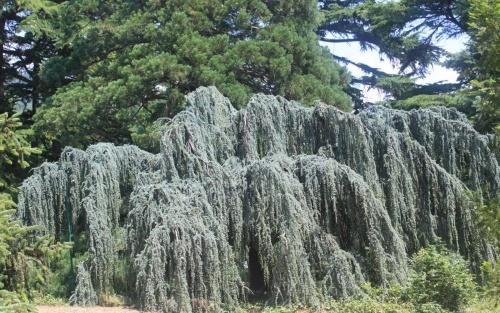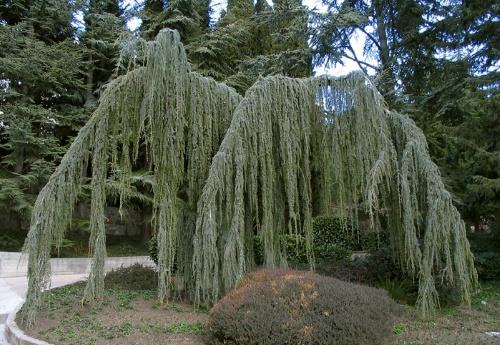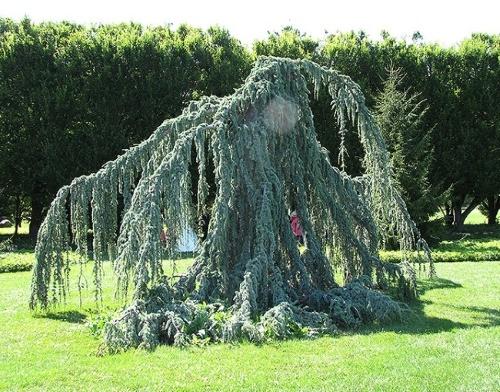Weeping cedar is a highlight among conifers
 Evergreen coniferous trees, directing their crown to the sky, look spectacular and noble. But among them there are also species that prefer to be closer to the ground, for example, weeping cedar. Its long branches literally fall to the ground, hanging beautifully and smoothly from the central trunk. Their crown really resembles the crown of a willow tree with its cascading shoots.
Evergreen coniferous trees, directing their crown to the sky, look spectacular and noble. But among them there are also species that prefer to be closer to the ground, for example, weeping cedar. Its long branches literally fall to the ground, hanging beautifully and smoothly from the central trunk. Their crown really resembles the crown of a willow tree with its cascading shoots.
There are several varieties of cedar with a weeping crown. As a cultivated plant, the following cedars are most often found:
- satin gray;
- Lebanese;
- Himalayan.
Weeping cedar satin gray

Due to its decent size, such a cedar needs a lot of space. It will displace other plants growing nearby. The most lush and voluminous gray crown will be at the cedar in a bright place. He prefers loose soil, moderately moist, with the obligatory presence of drainage. Can grow in limestone soil. It winters without damage in the southern regions, surviving frosts down to minus 20 °.
It is possible to grow such a weeping cedar on your own only by grafting onto a regular Atlas cedar. With the seed method, it does not retain the desired qualities and an ordinary tall tree with straight shoots grows.
Lebanese Weeping Cedar
 Weeping form of the Lebanese cedar. The height of the tree does not exceed 6 m with the same spreading crown. The main branches hang down in an arched manner, and dense lateral shoots in the form of a mane grow on them. Bluish needles soft, almost not prickly. Cones are light brown, elongated. The root system is powerful, rod-shaped.
Weeping form of the Lebanese cedar. The height of the tree does not exceed 6 m with the same spreading crown. The main branches hang down in an arched manner, and dense lateral shoots in the form of a mane grow on them. Bluish needles soft, almost not prickly. Cones are light brown, elongated. The root system is powerful, rod-shaped.
The species has good drought and frost resistance, but grows slowly.
Himalayan Weeping Cedar
 By its nature, it is a very tall evergreen tree up to 25 m tall with a moderately wide crown up to 4 m in diameter. However, after grafting, it is often formed as a shrub. The top remains vertical, but the shoots themselves fall beautifully down and spread along the ground. The needles are quite long, from 3 to 5 cm, painted gray-green, growing in bunches. Egg-shaped cones are blue at a young age. As they mature, they darken and acquire a beautiful brownish-red color.
By its nature, it is a very tall evergreen tree up to 25 m tall with a moderately wide crown up to 4 m in diameter. However, after grafting, it is often formed as a shrub. The top remains vertical, but the shoots themselves fall beautifully down and spread along the ground. The needles are quite long, from 3 to 5 cm, painted gray-green, growing in bunches. Egg-shaped cones are blue at a young age. As they mature, they darken and acquire a beautiful brownish-red color.
The culture is characterized by good growth and superficial roots. Prefers a spacious area with diffused lighting. In close group plantings, cedar can shed needles.
In the southern regions it winters well without additional shelter. In terms of frost resistance, it bypasses both Atlas and Lebanese cedars, tolerating a temperature drop of up to 25 ° C.